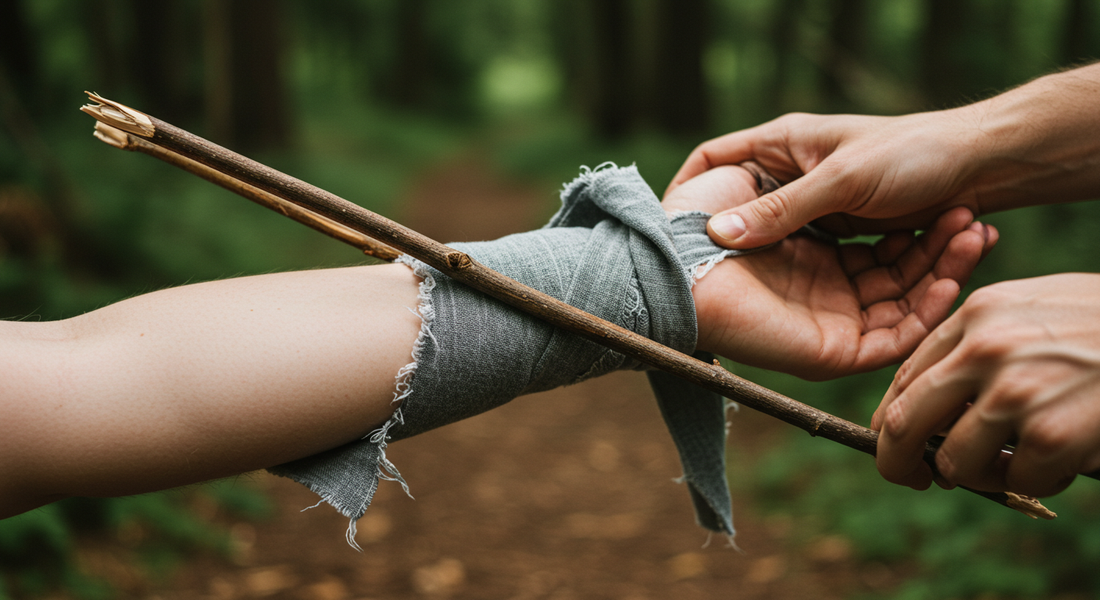
Basic First Aid: 5 Common Injuries and How to Treat Them in the Field:Wilderness First Aid Basics
Share
A self-reliant lifestyle, whether in the backcountry or your own backyard, is built on a foundation of preparedness. While we often focus on skills like finding food and shelter, one of the most critical and empowering capabilities is knowing how to respond to an injury. Possessing basic first aid skills can be the difference between a minor setback and a major crisis. It's about having the confidence to stay calm and take effective action when it matters most.
To provide a clear framework for any emergency, we'll use the "PAUSE" principle: Prepare your mind and your kit, Assess the situation and the injury, Utilize the skills and supplies you have, and know when to Seek professional help. This guide covers five common injuries, providing essential knowledge for treating them in the field.
Injury 1: Severe Bleeding and Lacerations
Knowing how to treat cuts and deeper lacerations is a cornerstone of first aid. Uncontrolled bleeding is one of the most immediate threats to life, and a quick, effective response is vital.
-
Applying Direct Pressure: The first and most important step is to apply firm, direct pressure to the wound. Use a sterile gauze pad or the cleanest cloth available. Press down consistently and elevate the limb above the heart if possible. Do not be tempted to remove the pad to check the wound, as this can dislodge clots and restart the bleeding. If blood soaks through the first dressing, do not remove it; simply add another layer on top and continue to apply pressure.
-
Packing and Pressure Dressing: For deeper wounds, it may be necessary to pack the injury with sterile gauze before applying a pressure dressing. Once the bleeding has slowed, wrap the wound tightly with a bandage or cloth to maintain pressure. The dressing should be snug enough to control bleeding but not so tight that it cuts off circulation entirely.
Injury 2: Burns (Thermal and Chemical)
Burns are a common injury that can range from minor to life-threatening. Proper initial burn treatment first aid is crucial for minimizing damage and preventing infection.
-
The Three Degrees of Burns:
-
First-degree: Affects the top layer of skin (e.g., sunburn). Causes redness, minor pain, and swelling.
-
Second-degree: Affects the top two layers of skin. Causes blisters, severe pain, and redness.
-
Third-degree: Destroys all layers of skin and may damage underlying tissue. The area may appear white or charred, and there may be no pain due to nerve damage.
-
-
Cooling and Dressing: For first and second-degree burns, the immediate priority is to cool the area. Run cool (not cold) water over the burn for 10-20 minutes. Do not use ice, as it can cause further tissue damage. After cooling, cover the burn loosely with a sterile, non-stick dressing or clean cloth. Do not apply butter, oil, or other folk remedies, as they can trap heat and introduce bacteria. Third-degree burns are a medical emergency; cover the area with a clean, dry cloth and seek immediate professional help.

Injury 3: Sprains and Fractures
A fall or a sudden twist can easily lead to a sprain or a fracture, two of the most common wilderness first aid basics.
-
Recognizing the Signs: A sprain (stretched or torn ligament) or fracture (broken bone) often presents with pain, swelling, bruising, and limited mobility. In the case of a fracture, there may be a visible deformity or the sound of a snap or crack.
-
The R.I.C.E. Method: This is the standard initial treatment for sprains and suspected minor fractures:
-
Rest: Stop all activity and avoid putting weight on the injured area.
-
Ice: Apply a cold pack or ice wrapped in a cloth to the injury for 15-20 minutes every few hours to reduce swelling and pain.
-
Compression: Wrap the injured area with an elastic bandage to provide support and limit swelling.
-
Elevation: Keep the injured limb elevated above the level of the heart.
-
-
Basic Splinting: If you suspect a fracture and help is not immediately available, you may need to immobilize the injury with a splint. A splint can be made from any rigid object—sticks, trekking poles, a rolled-up magazine—padded with cloth. Place the splint alongside the injured limb so that it extends beyond the joints above and below the break. Secure it firmly with bandages, tape, or strips of cloth.
Injury 4: Dehydration and Heat Stroke
In warm conditions, heat-related illnesses are a serious threat. Prevention is key, but knowing how to respond is essential.
-
Prevention and Recognition: The best treatment is prevention: drink plenty of water, take breaks in the shade, and wear light clothing. Signs of dehydration include thirst, dark urine, and fatigue. This can progress to heat stroke, a life-threatening condition characterized by a high body temperature, confusion, a lack of sweating, and a rapid pulse.
-
Immediate Cooling and Rehydration: For dehydration, move to a cool place and sip water or an electrolyte drink. For suspected heat stroke, this is a medical emergency. Call for help immediately. While waiting, move the person to the shade, remove excess clothing, and do everything you can to cool them down—apply cool, wet cloths to the body, especially the head, neck, armpits, and groin.
Injury 5: Allergic Reactions
An unexpected encounter with an insect or plant can lead to a severe allergic reaction, or anaphylaxis.
-
Identifying Signs of Anaphylaxis: A mild reaction might involve a localized rash and itching. Anaphylaxis is a severe, whole-body reaction. Symptoms include difficulty breathing, swelling of the face or throat, hives all over the body, and dizziness or fainting.
-
The Role of Antihistamines: For minor reactions, over-the-counter antihistamines (like Benadryl) can be effective in reducing itching and swelling. However, they are not a substitute for epinephrine in the case of anaphylaxis. If someone has a known severe allergy, they should carry an epinephrine auto-injector (EpiPen). This is the only treatment that can reverse the life-threatening symptoms of anaphylaxis.
